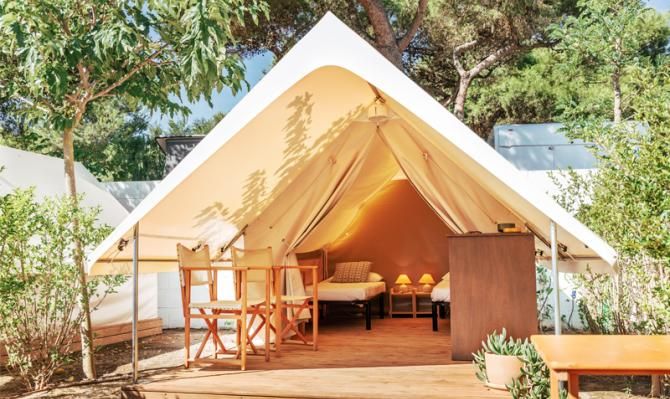The opportunities offered by the camping sector in Spain
Camping has traditionally been a type of accommodation aimed at less profitable and eminently domestic tourism, with a relatively moderate share of the tourism industry. However, the pandemic represented a watershed for this model and it has been rediscovered by a large number of travellers who’ve found a much more modern sector thanks to the heavy investment being made, as well as a type of accommodation that offers high quality, an extensive range of complementary services and attractive locations. In this article we analyse the latest trends and prospects for the sector.

Accommodation is the main sector within the tourism industry, generating around 21.5% of total tourism consumption in Spain. Within accommodation, the most important branch is the hotel industry, although after the outbreak of the pandemic other branches have emerged due to their greater growth potential. This is the case of camping, which has posted the best records post-pandemic. According to data from the Campsite Occupancy Survey produced by the National Statistics Institute, the camping sector is registering excellent growth in demand. In May, overnight stays were 25.7% higher than in the same month of 2019, thanks to the good performance by domestic demand which grew by 31.0% compared with May 2019, as well as the dynamism of international demand, up by 21.0% compared with the same month in 2019.
However, it should be noted that, although demand for campsites has performed very positively, it has not been unaffected by the macroeconomic trends. Demand by the British, which is noticeably one of the weakest when analysing the tourism industry in Spain as a whole, has also suffered considerably in the case of campsites. As of May, there was still a 9.6% drop compared with the same period in 2019.
Camping is the branch that has posted the best records post-pandemic. In May,
overnight stays were 25.7% higher than in the same month in 2019, thanks to the good performance by domestic demand
When comparing these figures with those of other types of accommodation, it can be confirmed that the growth in the camping sector has been differential. As shown by the chart below, the volume of overnight stays at campsites in the first five months of 2023 was 29.0% higher than the level recorded in the same period in 2019. In contrast, growth was just 1.0% in the hotel market, in themselves very positive figures given that they suggest the sector has regained a very high level of demand, and even more so considering that 2019 was a highly favourable year for the sector. This situation is similar with the tourist apartment market, which has not yet got back to its 2019 levels.
The volume of overnight stays at campsites in the first five months of 2023 was 29.0% higher than the level recorded in the same period in 2019
The good figures for the camping sector are not only due to the fact that they attract a relatively larger proportion of domestic tourism, which recovered earlier and more strongly than international tourism. As shown by the chart below, it’s true that domestic demand is the main driver for camping, accounting for 56% of total overnight stays in the last 12 months for which data are available (up to May 2023). However, what this figure reveals is that share of international demand is also very important and that, in addition, this has performed much more positively for campsites than hotels across almost all inbound markets. The traditional inbound countries for Spain’s tourism industry are particularly of note as they are very well-established, such as Germany and France, which account for 9.6% and 8.7% of total overnight stays, respectively and have recorded growth of more than 65.8% and 24.5% so far this year compared with the same period in 2019. Also notable is the preponderance of the Netherlands, which is the sector’s main source of inbound tourism, with 9.7% of total overnight stays (well above the 3% for the hotel market), and which has also grown by 28.3% compared with 2019 in the first five months of the year. On the other hand, the weakness of the British market is much more evident in the camping sector, where it has posted a 19.8% drop (whereas overnight stays are rising in the hotel market, albeit only slightly).
Without doubt, the post-pandemic figures for the camping sector are generally positive. This is due to the fact that, in the early stages of tourism’s post-pandemic recovery, camping was very appealing because tourists were looking for nearby destinations that could ensure greater social distancing. However, the sector continued to perform well once the pandemic was over, which leads us to believe that the growth observed since 2022 is being supported by factors more closely linked to its competitiveness. Firstly, during the pandemic period the camping market was discovered by customers who had not previously considered it, perhaps eliminating some prejudices towards the sector and thereby broadening its potential client base. Secondly, this increase in demand has occurred during a period of great transformation for the sector, in which its management is becoming more professional and the rate of investment has increased significantly, seeking to improve the quality of its supply in order to compete for a larger market. The result has been that, after the pandemic, some tourists have not only found a type of accommodation with attractive services and facilities but have done so at a time when its competitiveness and quality is on the up. This has meant that the exceptional spike seen in demand during the pandemic has become much more structural.
One of the questions that emerges from this analysis is the extent of the sector’s potential growth. Looking back, before the pandemic camping had not increased its share in the accommodation market for 20 years. As can be seen in the chart below, between 2001 and 2019 it absorbed between 8.2% and 8.8% of the total demand. With the outbreak of the pandemic, however, this market share increased to 15.0% in 2020, thanks to the fact that it was quickly able to regain levels of domestic demand similar to those of 2019. In subsequent years, due to the recovery in tourism demand in the rest of the accommodation market, we can see that camping’s market share normalised, reaching 10.1% in 2022, a figure that remains stable when we look at the last 12 months with available data (10.0% between May 2022 and April 2023).
Looking ahead to the next few years, we would expect the sector to continue to attract a larger share of the market. In order to know to what extent, it’s useful to break down the data by region, in which we can observe some models to follow and where we would expect part of the sector to move towards.
Looking ahead to the next few years, we would expect the sector to continue to attract a larger share of the accommodation market
As mentioned above, in Spain as a whole the relative weight of the camping sector stands at 10.1% (data from 2022). However, by autonomous region there are six cases in which this share lies between 20% and 25%. Moreover, these are not regions where the tourism sector is relatively small and uncompetitive and where presumably the camping sector would have found it "easier" to absorb a good portion of the market. These regions are Catalonia, Murcia and the Community of Valencia, which are among the most developed tourist destinations in Spain and Europe. These three examples illustrate that, with good management and clear commitment, camping has the capacity to attract more markets, especially in those autonomous regions where its share is somewhat smaller but where very high growth rates are also being recorded. A case in point is the great growth potential in Andalusia, where tourism is already very well-established and the camping sector is growing very rapidly (overnight stays in 2022 were 25.5% higher than in 2019) but it still has a relatively small market share (8.6%). This is also the case in other regions in which tourism is less important, such as Asturias, where the camping sector is already relatively well-established (16.9% of the market), or in Castile-La Mancha, Castile & Leon and Galicia, with a somewhat smaller share but a great capacity for growth in rural and nature tourism, types of tourism historically associated with camping.
With good management and clear commitment, camping has the capacity to attract more markets, especially in those autonomous regions where its share is somewhat smaller but very high growth rates are also being recorded

In short, Spanish tourism is diverse and this is, in fact, one of its great strengths. The development of Spain’s camping sector is very good news for the competitiveness of its tourism industry, even more so since this development stems from the sector’s extensive modernisation, both in terms of its management (with new capital) and its business model (wider range of complementary services and facilities). Looking ahead to the coming years, we expect this upward trend to consolidate, creating opportunities in less developed tourist destinations and resulting in a better distribution of the wealth generated by the tourism industry.
